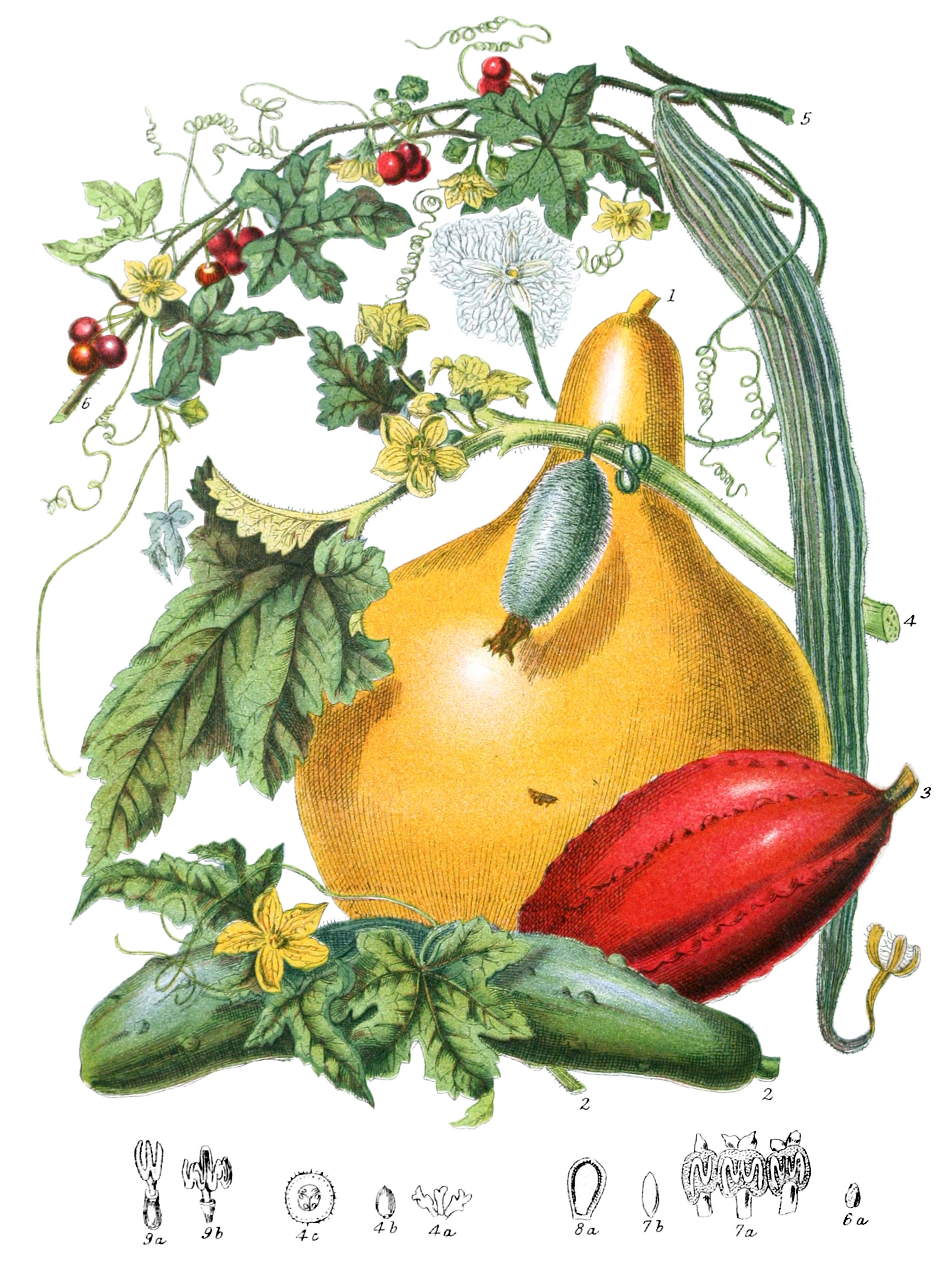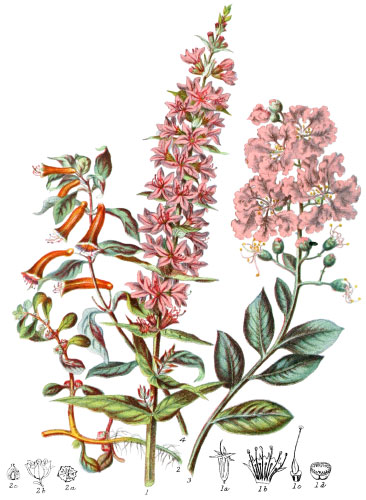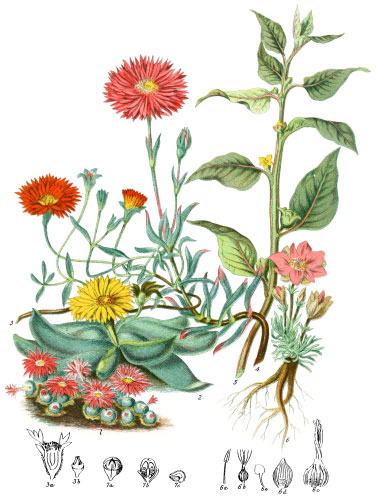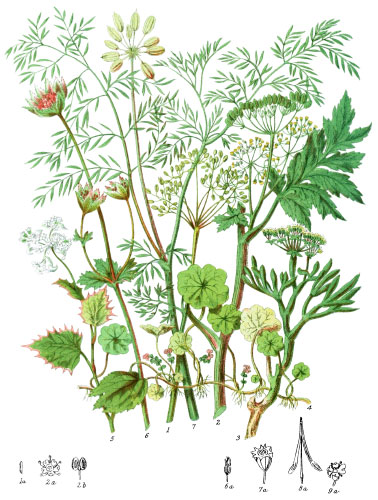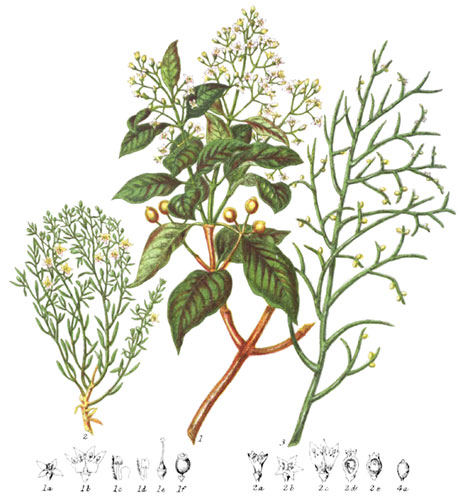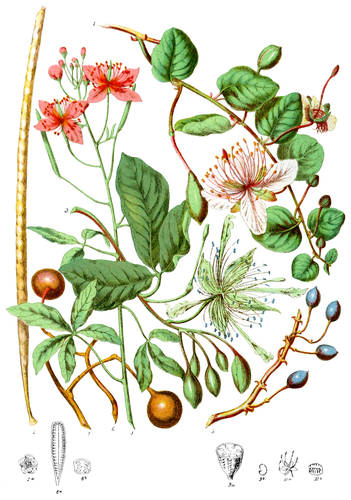Key characteristics
Herbaceous plants, with annual or perennial roots, fibrous or tuberous. The stem is generally brittle or succulent, trailing and climbing by the aid of tendrils. The leaves are usually five-parted, or have five distinct ribs; sometimes they are triple or heart-shaped, rough, with small warts or hairs. The flowers are white, yellow, or red; occasionally small and green. The stamens and pistils are in different flowers; the calyx is five-toothed; the corolla is five-parted; sometimes scarcely distinguishable from the calyx, having well-developed cells, and strongly-marked veins; sometimes fringed at the edges as in Tricosanthes (5). The stamens are five, either distinct, or in two pairs, with one single, inserted on the corolla, alternate with its divisions: the anthers are two-celled, very long and waving. The style is short, stigmas thick, downy, lobed, or fringed. The fruit is more or less succulent, crowned by the remains of the flower. The seeds are ovate, flat, or rounded, enveloped in a skin, which is either juicy or dry and membranous, often thickened at the margin, as in the vegetable marrow (8);* sometimes winged; they contain no albumen.
These pants have affinity with the Loasa and Evening Primrose tribe.
Acrimonious juicy plump and oily seeds are the chief characteristics of the fruits.
Select plants in this order
Not all plants listed are illustrated and not all plants illustrated are listed.
- Several specimens of this Tribe abound in the East, and were known to the ancients. Their use may be traced to remote antiquity. Cucurbita claviformis is supposed to be the gourd of Jonas.
- Cucurbita Lagenaria (1) has a remarkable fruit, in shape like a bottle, often attaining three or four feet in length, and eighteen inches in circumference; in some countries it is called Calabash, after the Portuguese name. It is very common in Egypt and Arabia, and serves many purposes. The pulp is white, and unfit for food; but the shell, when emptied an dried, becomes so hard and tough that it will contain liquids, for which use it is constantly employed, as well as for dishes. In the East Indies, it is usually planted under Mango trees. The larger gourds are made into travelling trunks, which, according to Rumphius, an old Dutch author, are strong and excellent; they would no doubt, be well adapted for modern railway journies, if introduced to Europe.
- C. Citrullus, the Water-melon, is one of the most valuable fruits of the East, affording an agreeable, cooling food, the general refreshment of all classes. In the soil deposited by the inundation of the Nile, it is cultivated with great produce.
- C. Melo is known under several varieties of Melon in Europe, but is of very superior quality in the floating islets of the rivers of Cashmere, composed of masses of decayed roots of Water-lilies and other vegetable remains, which accumulate, and form the most fertile Melon gardens in the world, the fruit being of large size and exquisite flavour.
- C. Pepo is the celebrated Pompion or Pumpkin. In favourable situations, the fruit reaches four feet in circumference, and is known to readers of fairy tales as having been transformed into a coach for Cinderella. On the Continent, it forms a constant article of food in soups and stews, and is cheap and wholesome.
- C. ovifera is the useful Vegetable Marrow; a variety of this, the Succade gourd, is also much esteemed.
- The large rough fruit of C. Melopepo is the favourite species in North America.
- The fleshy pulp of C. maxima, the red gourd, when boiled, resembles the Carrot in appearance and flavour.
- Cucumis sativus (2) is the most important in this country, and has been brought to a great size by skill and cultivation. In all northern lands it is grown, and in Russia forms a daily meal for all classes during the summer months; its value as food consists in being kept from acquiring its natural bitterness.
- C. anguina is eatable when young, the bitter juices being extracted by boiling; it is three or four feet long, and of a red colour when ripe, curling about stems like a snake.
- Momordica balsamina (3) is said to impart healing qualities to oil, and is thus used for wounds in India.
- The fruit of M. operculata open with a lid, after the manner of Lecythis, which forms a connecting link with the Myrtle tribe.
- M. Elaterium (4) was known to Pliny, having attracted the notice of the ancients for its singular power of expelling the seeds from the fruit as soon as it becomes ripe. The cause of this was discovered by Dutrochet to be the expansion of the fluid within; when that occurs, the force is so great as to break away the fruit from the stalk, and to shoot forth the seeds like shot from an air-gun. The juice was used as a medicine in ancient times, and a poisonous drug is still prepared from it.
- The fruit of Tricosanthes (5) is remarkable for its extreme length and snake-like form: in a conservatory at Syon, it has been seen upwards of six feet long. Here it is not used, but in India the natives make it one of the various materials for curries.
- Bryonia (6) is very ornamental in our hedges, when the berries are red in autumn; goats are said to be the only animals that feed on it.
- Coccinia indica (9)† is very common in Indian hedges, furnishing favourite food to small birds, and a curry to the natives.
- Sicyos is the single-seeded Cucumber of North America; a trailing plant with small fruit.
- Zanonia indica, the Bandolier fruit, has the taste and smell of a cucumber.
- In America, the oil from the seeds of Feuillæa is burnt in lamps.
- The large oily seeds of Telfairia pedata are eaten by Negroes in Africa. The seeds of several species are used medicinally in Brazil.
Locations
This Tribe inhabits hot countries in both hemispheres, chiefly within the Tropics; a few species belong to Europe and North America, and several are natives of the Cape of Good Hope; the greatest number are found in India; many occur in Brazil and Peru; some are already known in Australia—one in Norfolk Island. Bryonia is the only British example.
Legend
- Curcurbita Lagenaria, Bottle Gourd. India.
- Cucumis sativa, Cucumber. India
- Momordica balsamina, Balsam Apple. India.
- Momordica Elaterium, Squirting Cucumber. South Europe.
- Stamens.
- Seed.
- Section of Ovary.
- Tricosanthes anguina, Snake Gourd. China.
- Bryonia dioica, Red-berried Bryony. Britain.
- Seed.
-
- Cucumis Melo, Melon. Stamens.
- Seed.
-
- Seed of Vegetable Marrow.
-
- Pistil of Coccinia indica.
- Stamens.
- *8 was mentioned in the original description but only 8a was illustrated.
- †9 was not in the original illustration.
Explore more
Posters
Decorate your walls with colorful detailed posters based on Elizabeth Twining’s beautiful two-volume set from 1868.
Puzzles
Challenge yourself or someone else to assemble a puzzle of all 160 botanical illustrations.
